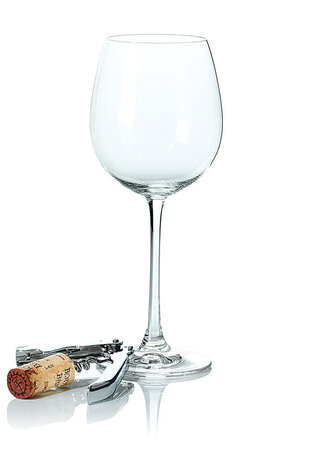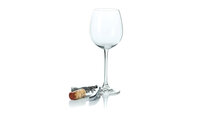THE RIGHT GLASS
Perfect wine tasting stems from the glass


"If wine sheds tears, this is no reason to be sad," some might say, this occurrence corresponding to a law of physics. And there are many more such laws to be aware of when the subject of wine is on our lips.
Drinks can be consumed from many different vessels - however, sophisticated wine tasting is only possible from a glass. The right glass for the right wine is an essential part of any tasting session. Only in a glass can the wine fully unfurl.
In the classical sense, every wine glass has a foot, a stem and a bowl with a rim (exceptions, such as tumblers, remain broadly unsuccessful, no doubt because they don't have a stem). The rim should feel pleasant to the touch when meeting the lips of the consumer and allow the wine to flow correctly. After a sip has been taken, the flat foot of the glass should ensure its stability on the tabletop. Between the foot and the bowl we can find the stem. A good stem stands out for its fineness and elegance. The connoisseur holds the glass by the stem using their thumb, index and middle finger. Holding the wine glass directly by the bowl is frowned upon. Through its shape (and this does not only apply to wine glasses) the glass is to convey the balance of the nuances of flavour in the drink to the mouth of the consumer.
In the case of a wine glass with an open bowl the head of the drinker stays upright, whereas a narrow glass means that they will tilt their head backwards. The reason for this is that when the head is up straight, the taste buds at the tip of the tongue in particular come into play, meaning that the sweet notes of the wine can be appreciated. When the head is tilted backwards, the wine is directed towards the back of the tongue, where the acid content of the wine is perceived. The taste buds on the tongue recognise the following flavours: sweet at the tip of the tongue, salty and sour at the edges and underneath, and bitter at the back.
Not only the tongue, but also sense organs like the eyes and nose play a decisive role in wine tasting. Before the very eyes of the person drinking it, the wine develops its richness, its sugar and alcohol content. The visual appearance gives information on the type of wine, its age and its stage of development. And now, in this context, a few words on the so-called curtains in the wine glass. These curtains, also described as tears, legs or church windows, can be attributed to the likewise 'so-called' Marangoni effect. These are chemical processes, which follow the chemical law that alcohol evaporates faster than water. This means that a fine, aqueous layer forms on the surface of the wine with a high surface tension. If the process is followed further, we can see droplets form. When these droplets slide down the wall of the glass, they are referred to as the abovementioned tears, curtains, legs... It is said that the higher the alcohol content, the more tears the wine sheds.
And now onto the nose. The nose perceives the different layers of aroma in the wine. This in turn is influenced by the size of the glass. A correctly selected glass has to be capable of offering the wine taster the chance to analyse every facet of the wine. Ranging from fleeting, fruity, flowery notes, which develop in the top of the bowl, to vanilla or wood tones in the base of the bowl. Wine which has had time to breathe after being poured into a decanter from the bottle, is ready to release such aromas. If we wish to discover as many aromas as possible, it is recommendable to swirl the wine in the glass, whilst leaving the foot of the glass on the table.
Anyone who decants the wine or has it decanted, should know that emptying the bottle into a decanter has two advantages. Firstly: Young wine, which has been decanted several hours before serving, is able to breathe properly. Secondly: Vintage wine, decanted shortly before drinking, maintains the properties developed in the bottle. It is imperative that when decanting white wine, the decanter should be closed with a stopper, so that the aromas cannot escape. So it's worth keeping your ears open; you never know when you might hear talk of wine tasting on the grapevine!
